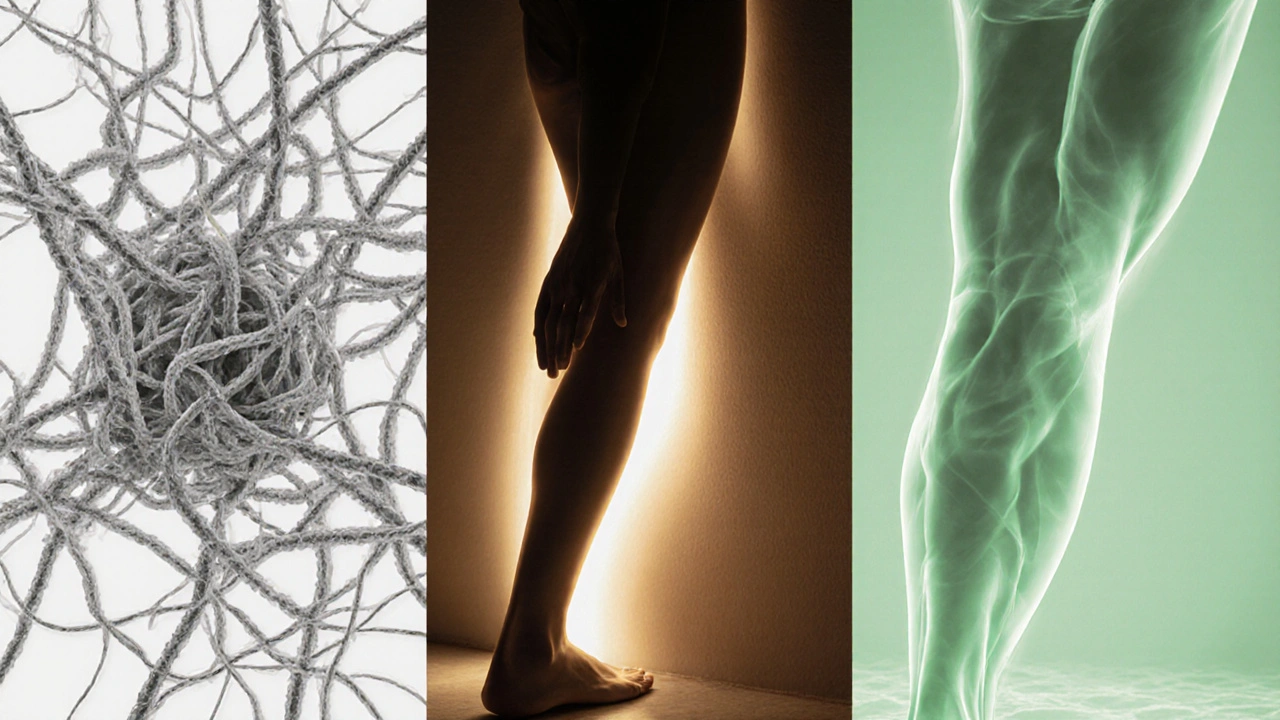Demystifying Fascia Stretching: What It Is and How It Helps

Fascia Stretch Hold Time Calculator
How Long Should You Hold Your Stretch?
Based on research from the Journal of Bodywork and Movement Therapies, fascia needs sustained pressure for effective release. Find your ideal hold time below.
Your Optimal Fascia Stretch Duration
Based on your selections, you should hold this stretch for:
(Research shows fascia needs 90-120+ seconds to release)
Tip: Hold for this time with gentle pressure. Breathe deeply and allow your body to relax into the stretch. This isn't about forcing deeper—it's about patience.
While holding your stretch:
1. Set a timer for 3:00
2. Focus on deep, slow breathing
3. Notice subtle changes in your body
Most people think stretching is just about pulling on muscles to feel tighter hamstrings or looser shoulders. But what if the real bottleneck isn’t your muscle-it’s the web of tissue wrapping around it? That’s where fascia stretching comes in. Fascia isn’t something you hear about in typical gym classes or yoga videos. Yet, it’s the silent player behind stiffness, pain, and restricted movement. Understanding how to stretch it properly can change how your body feels day to day.
What Exactly Is Fascia?
Fascia is the body’s connective tissue network. Think of it like a full-body spiderweb made of collagen and elastin fibers. It surrounds every muscle, bone, nerve, blood vessel, and organ. It holds you together, gives structure, and lets parts slide smoothly over one another. When healthy, fascia is soft, slippery, and flexible. When it gets stuck-because of injury, poor posture, or sitting too long-it turns stiff, sticky, and tight. That’s when you feel tightness that doesn’t go away with regular stretching.
Unlike muscle fibers that shorten and lengthen, fascia responds differently. It doesn’t stretch like rubber. Instead, it needs sustained pressure and slow movement to release adhesions. That’s why pulling your leg into a hamstring stretch for 15 seconds might not help if the real issue is the fascia around your glutes or lower back sticking to the muscle beneath.
Why Regular Stretching Often Fails
You’ve probably done your daily hamstring stretch, quad stretch, and shoulder rolls. You even stretch after every workout. But you still feel stiff. Why? Because you’re stretching the muscle, not the fascia.
Regular static stretching targets muscle spindles-the sensors that tell your brain to relax the muscle. But fascia doesn’t have those sensors. It responds to mechanical stress over time. If you’re bouncing in a stretch or holding it for only 20 seconds, you’re not giving fascia enough time to unwind. Studies show that fascial tissues need at least 90 to 120 seconds of gentle, sustained pressure to begin releasing.
Imagine trying to untangle a knotted headphone cord by yanking it. You’re not fixing the knot-you’re just making it worse. Fascia works the same way. Forceful stretching can irritate it, leading to more tightness. The key isn’t intensity. It’s patience.
How Fascia Stretching Works
Fascia stretching isn’t about going deeper into a pose. It’s about slowing down. It’s about letting your body sink into a position and staying there. The goal isn’t to feel pain. It’s to feel a gentle, spreading warmth-the kind that says, "Oh, this is actually letting go."
Here’s how it works:
- You enter a stretch slowly, finding a point of mild tension-not pain.
- You hold it for 2 to 5 minutes, breathing deeply.
- Your nervous system starts to relax, signaling the fascia to soften.
- Over time, the sticky layers begin to glide again.
This is why foam rolling and myofascial release tools feel so good. They apply slow, even pressure to break up adhesions. But you don’t need tools. Your own body weight, gravity, and time can do the same job.

Simple Fascia Stretching Techniques You Can Try Today
You don’t need a trainer or expensive equipment. Here are three effective, no-equipment methods:
1. The Supine Spinal Twist (Fascia Release for Back and Hips)
Lie on your back. Bend your knees and drop them slowly to one side. Keep your shoulders flat on the floor. Let your arms open out to the sides like a T. Breathe into your lower back. Stay here for 3 minutes. Switch sides. You’ll feel tension release not just in your spine, but down into your hips and even your chest.
2. The Standing Quadriceps and Hip Flexor Release
Stand near a wall for balance. Bend one knee and grab your ankle. Don’t pull your heel to your butt. Instead, let your knee drift slightly forward, so your hip opens. Soften your lower back. Breathe. Hold for 3 minutes. You’ll notice the tightness in your front hip doesn’t come from your quads alone-it’s the fascia wrapping around your pelvis and thigh.
3. The Wall Hamstring and Calf Release
Stand facing a wall. Place one heel on the wall at hip height. Keep your leg straight. Lean your torso gently forward until you feel a deep, even pull along the back of your leg. Don’t lock your knee. Stay still. Breathe. Hold for 4 minutes. This isn’t just stretching your hamstrings-it’s releasing the fascial chain that runs from your foot, up your calf, behind your knee, and into your lower back.
What Fascia Stretching Can Do for You
People who start regular fascia stretching report changes that surprise them:
- Less morning stiffness-even after a long night’s sleep
- Improved range of motion without forcing it
- Reduced chronic lower back or shoulder pain
- Faster recovery after workouts
- Better posture without consciously "pulling your shoulders back"
One 2023 study in the Journal of Bodywork and Movement Therapies followed 68 people with persistent lower back pain. Half did traditional stretching. The other half added 10 minutes of daily fascia release using slow, sustained holds. After 8 weeks, the fascia group reported 47% more improvement in mobility and pain reduction than the control group.
Common Mistakes to Avoid
Fascia stretching sounds simple. But it’s easy to mess up:
- Mistake: Holding stretches for less than 90 seconds. Fix: Set a timer. You’ll be surprised how long 3 minutes feels.
- Mistake: Pushing into pain. Fix: If it hurts, back off. You want gentle pressure, not a fight.
- Mistake: Doing it once a week. Fix: Consistency matters more than duration. Ten minutes daily beats an hour once a week.
- Mistake: Ignoring breathing. Fix: Slow, deep breaths signal your nervous system to relax. If you’re holding your breath, you’re tensing up.

Who Benefits Most From Fascia Stretching?
You don’t have to be an athlete to benefit. Fascia stretching helps:
- Office workers who sit all day and feel stiff in the neck and hips
- Older adults who notice reduced flexibility and balance
- Runners and cyclists with tight calves or IT bands
- People recovering from injury or surgery
- Anyone who feels "tight" but doesn’t know why
It’s especially useful for people who’ve tried everything else-massage, physio, yoga, foam rolling-and still feel stuck. Fascia stretching doesn’t replace those things. It complements them by targeting the root cause: tissue adhesion.
How to Make Fascia Stretching Part of Your Routine
Start small. Pick one area you feel tight-maybe your lower back or the front of your hips. Spend 5 minutes a day on it. Do it in the morning before coffee, or right before bed. Use a quiet space. Turn off your phone. Focus on your breath. Don’t rush.
After a week, you’ll notice something: your body feels lighter. Movements feel easier. You might not even realize you’ve stopped wincing when you bend over to tie your shoes.
Fascia doesn’t care about your goals. It doesn’t care if you run marathons or just want to play with your kids without aching. It just wants to move freely. And with a little patience, it will.
Can you stretch fascia with a foam roller?
Yes, but only if you use it correctly. Rolling fast or aggressively won’t release fascia-it’ll just irritate it. Use slow, controlled rolls, pausing on tender spots for 60 to 90 seconds. Let your body sink into the pressure. Think of it as "melt time," not "pain time."
Is fascia stretching the same as myofascial release?
They’re closely related. Myofascial release is a broader term that includes techniques like foam rolling, massage, or using balls to apply pressure. Fascia stretching refers specifically to slow, sustained stretches held for minutes. Both aim to release stuck fascia, but stretching uses body weight and gravity, while myofascial release often uses tools.
How long does it take to see results from fascia stretching?
Some people feel a difference after one session-especially if they’ve been sitting all day. For lasting changes, like reduced chronic pain or improved mobility, most people notice real progress in 2 to 4 weeks with daily 10-minute sessions.
Can fascia stretching help with scar tissue?
Yes, gently. Scar tissue is dense, sticky fascia. After healing is complete (usually 6-8 weeks post-injury), slow, sustained pressure and movement around the scar can help soften and realign the tissue. Always consult a professional if you’re unsure about timing or technique.
Do I need to stretch every day?
You don’t have to stretch every day, but consistency matters more than frequency. Even 5 minutes every other day can make a difference. If you miss a day, don’t stress. Just get back to it. Fascia responds to regular, gentle input-not perfection.
Next Steps
If you’ve been feeling stiff, achy, or just "not quite right," fascia stretching might be the missing piece. Start with one technique. Try it for 7 days. Pay attention to how your body feels-not just during the stretch, but hours later. Do you move easier? Do you wake up without that familiar tightness?
It’s not magic. It’s biology. Your fascia has been holding onto old patterns. With time and patience, it can let go.





